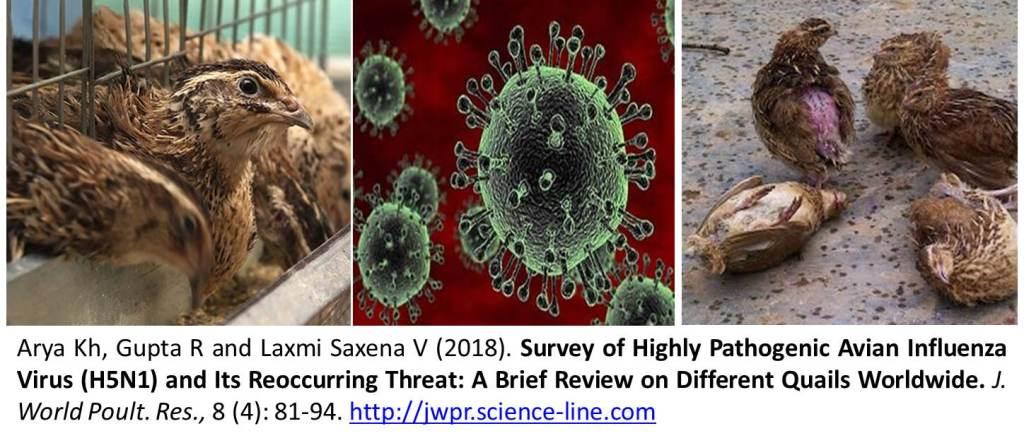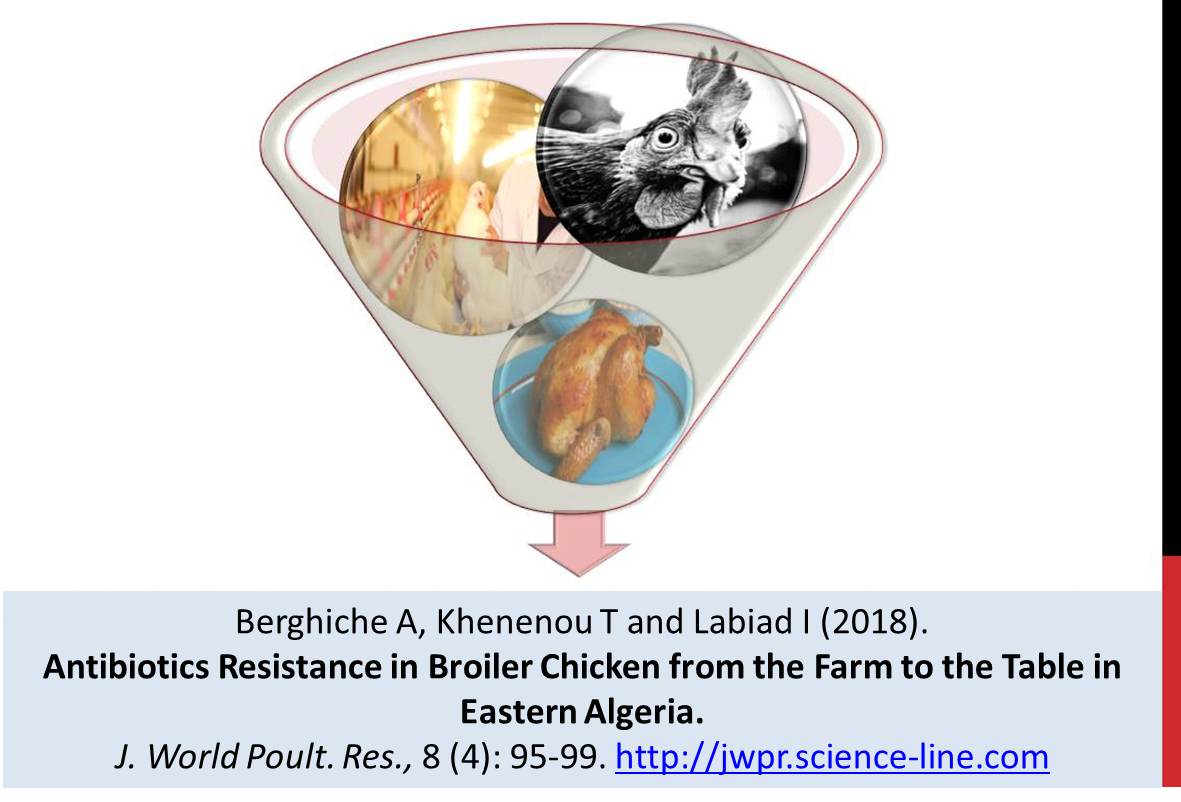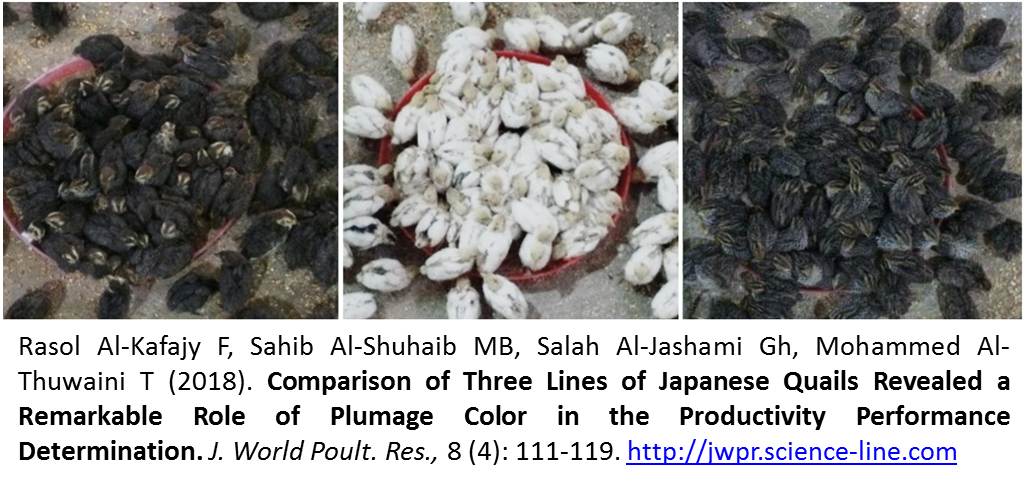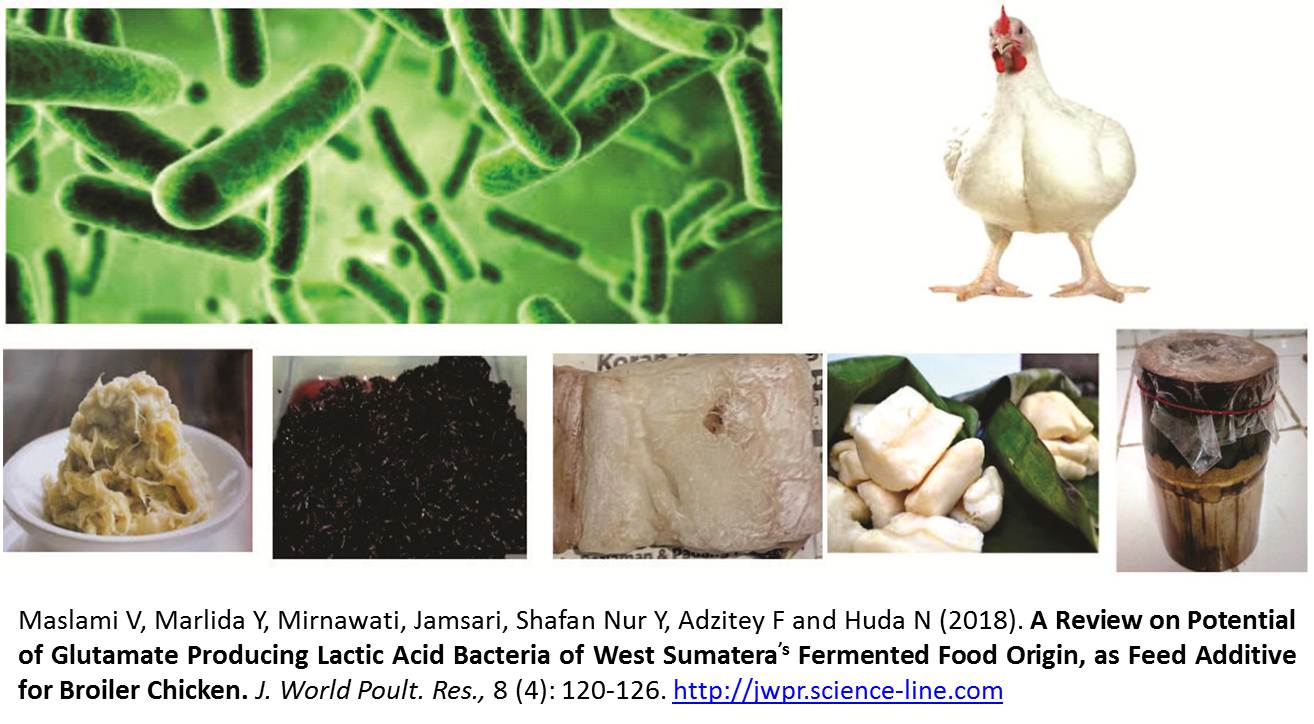Previous issue | Next issue | Archive
Volume 8 (4); December 25, 2018 [Booklet]
Survey of Highly Pathogenic Avian Influenza Virus (H5N1) and Its Reoccurring Threat: A Brief Review on Different Quails Worldwide.
Arya Kh, Gupta R and Laxmi Saxena V.
J. World Poult. Res. 8(4): 81-94, 2018; pii: S2322455X1800012-8
ABSTRACT:
This Review aims to understand the present status of influenza viruses and its epidemiology. The first case in India has been reported in the Dasarahalli village near Bangalore after six months of India’s declaration that it is free from H5N1 and H5N8 from world organization for animal health. The recent controversy regarding outbreaks and cross-species barrier resulted in highly contagious infection with fatal outcomes, triggered menace all over India with remarkable economic consequences. Thus, we had reviewed epidemiology, virology, surveillance, transmission, detection, treatment and associated control measures to depict the current perspective of Influenza epidemic. We also studied different Quails and its comprehensive portal susceptible to influenza and in-depth genetic characterization of virus due to new viral mutant causing host-virus complications, virus mutation, and vaccination with its prompt administration as it is the urgency of the era. Addressing aspects of the epidemiology of the H5N1 and drug resistance genomic signatures infecting poultry and Humans helps to frontier our ability to minimize data gaps and maximize the better results of the available H5N1 studies.
Keywords: H5N1, Avian influenza viruses, Quail, Transmission, Detection
Antibiotics Resistance in Broiler Chicken from the Farm to the Table in Eastern Algeria.
Berghiche A, Khenenou T and Labiad I.
J. World Poult. Res. 8(4): 95-99, 2018; pii: S2322455X1800013-8
ABSTRACT:
A survey was carried out to collect information on the place of chicken meat in the feed ration of families. It aims at assessing the occurrence of diseases, the method of their diagnosis, the commonly used antibiotics in poultry farms and their impact on the health of humans in the North-Eastern region of Algeria. The survey was based on a questionnaire that was sent to 102 families, 50 poultry farmers and 30 veterinary practitioners in the poultry sector in the region. Our investigation has revealed that the Algerian families’ consumption of chicken meat is the highest (85,3 %) compared with the other types of meats. As to the surveyed poultry farmers, the investigation has shown that most of them do not apply the residue disposal waiting times (70%). Concerning the surveyed veterinary practitioners, the investigation has, on the one hand, revealed that the cases of failure of antibiotic therapy are very common (96%), they primarily are due to the development of antibioresistance. It has, on the other hand, shown that veterinarians have become only drug distributors. These investigations have shown that there is a great lack of health monitoring, and a lack of quality of white meat. It has also been noted that there is a massive use of antibiotics and a dominance of anarchic use of veterinary drugs.
Keywords: Antibiotics resistance, Consumers, Inquire, Poultry farmers, Veterinary surgeons
[Full text-PDF] [XML] [Import into EndNote] [Citations on Google Scholar]
Biochemical Alterations in Hypervitaminosis D3 in Broiler Chicks Concomitantly Challenged with Endotoxin.
Kumar R, Brar RS, Banga HS and Sodhi S.
J. World Poult. Res. 8(4): 100-104, 2018; pii: S2322455X1800014-8
ABSTRACT:
Vitamin D3 is ten times more biologically active than vitamin D2, over supplementation of vitamin D3 causes hypercalcemia with deposition of calcium and phosphate as crystals in the visceral organs. Birds are considered more resistant to endotoxin and information on inflammation and homeostasis in birds supplemented with higher dose of vitamin D3 when suffer endotoxic shock is lacking. The present study was conducted to compare the effect on hemoglobin concentration and biochemical parameters of broiler chicks by administering toxic dose of vitamin D3 for 21 days concomitantly challenged with endotoxin. The chicks were randomly divided into four groups viz. A, B, C and D. Hemoglobin concentrations of control groups (A and B) and treatment groups (C and D) did not differ significantly (P< 0.05). Hypercalcemia and hyperphosphatemia was observed in both treatment groups in comparison to the control group. No significant (P< 0.05) change was observed in the concentrations of total protein and albumin and in the activity of plasma Alanine Aminotransferase, Aspartate Aminotransferase and Alkaline Phosphatase on day 28 of control (A and B) and treatment (C and D) groups. Vitamin D3 supplementation causes immunomodulation; hence acute endotoxic shock does not incite inflammatory response and disturb the homeostasis in broiler chicks.
Keywords: Broiler chicks, Hypercalcaemia, Hypervitaminosis D3, Hyperphosphatemia
[Full text-PDF] [XML] [Import into EndNote] [Citations on Google Scholar]
Effect of Combination of Encapsulated Black Cincau Leaves (Mesona Palustris Bl) and Probiotics on Production Performances, Yolk Cholesterol Content and Ammonia Level of Laying Hen.
Natsir MH, Sjofjan O, Ardiansah I, Khairani S and Elliyana.
J. World Poult. Res. 8(4): 105-110, 2018; pii: S2322455X1800015-8
ABSTRACT:
The purpose of this research was to determine addition of natural feed additives from combination of encapsulated black cincau leaves and probiotics on feed intake, feed conversion, hen day production (HDP), egg mass, income over feed cost (IOFC), egg weight, yolk cholesterol content and ammonia levels in excreta. One hundred ninety-two laying hens at 28 weeks were used in this experiment. Egg mass which used before this research was 64.63±2.97 g/ day with CV was 4.59%. The method which used was experimental of completely randomized design (CRD) with four treatments and six replications (eight-layers each). The treatments used were T0: basal feed; T1: basal feed + combination of encapsulated black cincau leaves and probiotics 0.5%; T2: basal feed + combination of encapsulated black cincau leaves and probiotics 1%; T3: basal feed + combination of encapsulated black cincau leaves and probiotics 1.5%. Data were analyzed by using analysis of variance, if any significant effect, it would be further tested by Duncan’s Multiple Range Test. The result showed that no siginficant effect (P> 0.05) on feed intake, feed conversion, HDP, egg mass, IOFC, egg weight and yolk cholesterol content, but any significant effect (P< 0.05) on ammonia level. This research concludes that using 1.5% of combination of encapsulated black cincau leaves and probiotics give better result than others.
Keywords: Black cincau leaves, Egg quality, Encapsulated probiotic, Hen production, Laying hen
Comparison of Three Lines of Japanese Quails Revealed a Remarkable Role of Plumage Color in the Productivity Performance Determination.
Rasol Al-Kafajy F, Sahib Al-Shuhaib MB, Salah Al-Jashami Gh, Mohammed Al-Thuwaini T.
J. World Poult. Res. 8(4): 111-119, 2018; pii: S2322455X1800016-8
ABSTRACT:
The study was conducted to compare body weight, egg, and carcass characteristics, as well as several biochemical parameters amongst three lines of plumage color of quails, including, black, white, and brown (n= 200 each). Body weight was analyzed on a weekly basis throughout the study period (third– 13th week of age). Eggs were collected for seven consecutive weeks of sexual maturity (seventh – 13th week of age). In addition to egg quality measurements, 16 serum biochemical parameters were also determined. The brown line had exerted significantly higher values of body weight in most analyzed weeks of sexual maturity. It had given higher values of albumen height and shell thickness, as well as carcass dressing than other lines. Simultaneously, a significantly high number of eggs in the white line were observed in the most analyzed weeks. Besides, it had given higher values in terms of shell and yolk weights, as well as several carcass characteristics, such as the heart, thigh, breast, and back. The biochemical analyses had shown no significant differences amongst the analyzed populations with exception of a higher concentration of amylase in the brown line. In conclusion, our study revealed the presence of a clear superiority of the brown and white lines in terms of the meat and egg productivity, respectively. Therefore, we recommend breeders to raise brown and white lines for a better production of meat and eggs, respectively, whereas the black line has shown the least productive characteristics than other two lines throughout the study period.
Keywords: Eggs, Japanese quails, Line, Meat, Production, Serum
[Full text-PDF] [XML] [Import into EndNote] [Citations on Google Scholar]
A Review on Potential of Glutamate Producing Lactic Acid Bacteria of West Sumatera’s Fermented Food Origin, as Feed Additive for Broiler Chicken.
Maslami V, Marlida Y, Mirnawati, Jamsari, Shafan Nur Y, Adzitey F and Huda N.
J. World Poult. Res. 8(4): 120-126, 2018; pii: S2322455X1800017-8
ABSTRACT:
Increasing broiler populations must be supported by cheap and high quality feed. Improving the quality of feed can be done by adding feed additives. Glutamate is a non-essential amino acid that can be used as a feed additive in the form of flavoring agents in broiler feed which functions as a neurotransmitter of taste, basic structure of proteins, and in metabolism of the body. Lactic Acid Bacteria (LAB) are one of the microbes that are considered faster and safe in producing glutamate. Fermented foods of West Sumatera, Indonesia origin serve as sources of LAB include dadih (fermented milk), asam durian (fermented durian), ikan budu (fermented fish) and tapai (fermented rice and cassava). The West Sumatra’s fermented foods are potential sources of glutamate. Supplementation of glutamate in broiler diet can increase body weight, protein digestibility, reduce faecal ammonia and improve carcass quality (improve umami taste, and reduce bruises and abdominal fat).
Keywords: Carcass quality, Feed additive, Fermented food, Glutamate, Lactic acid bacteria, Performance
[Full text-PDF] [XML] [Import into EndNote] [Citations on Google Scholar]
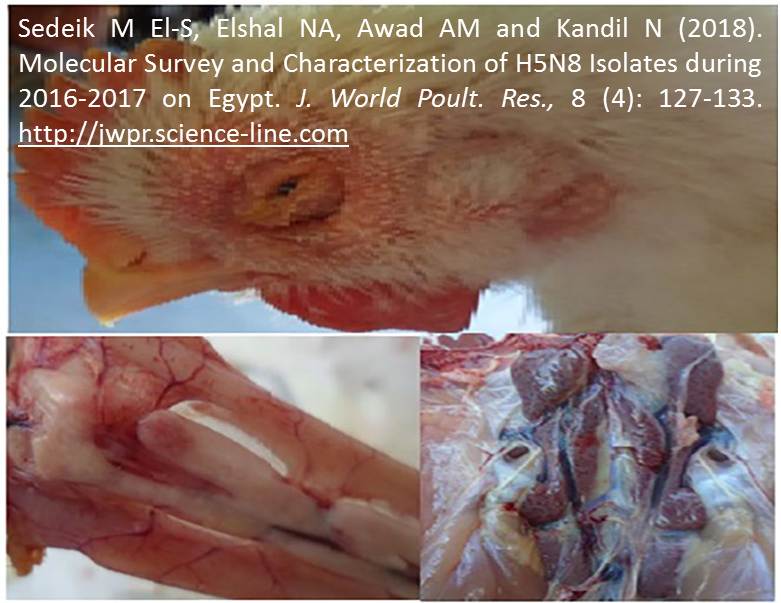
Research Paper
Molecular Survey and Characterization of H5N8 Isolates during 2016-2017 on Egypt.
Sedeik M El-S, Elshal NA, Awad AM and Kandil N.
J. World Poult. Res. 8(4): 127-133, 2018; pii: S2322455X1800018-8
ABSTRACT:
Avian influenza (AI) disease still threat poultry industry in Egypt causing great economic losses. In order to identify and characterize the agent of suggestive clinical cases of AI disease, 28 flocks showing clinical signs suspected to be due to AI infections have been investigated. By slide Haemagglutination (HA), the positive samples were 14/28 and concerning the results of real time- reverse transcriptase polymerase chain reaction (RRT-PCR), 2/14 samples were positive to AI H5, 7/14 to New castle disease virus (NDV), 1/14 to H9 and 4/14 co-infected (2 samples had NDV + AI H5 and others had NDV + AI H9). These positive PCR samples were subjected to further characterization by genotyping and sequencing analysis. The two isolated of H5 AI strain were classified to H5N8 which, related to Russian strains (clade 2.3.4.4) and the genetic analysis approved little relationship between these two H5N8 strain and the commercial AI vaccines with percent (80- 91.7%). So, the researchers should have more monitoring for these viral diseases with effective biosecurity and quarantine measures to minimize the disease occurrence.
Key words: Avian influenza, flocks, molecular, survey
[Full text-PDF] [XML] [Import into EndNote] [Citations on Google Scholar]
Previous issue | Next issue | Archive
![]() This work is licensed under a Creative Commons Attribution 4.0 International License (CC BY 4.0).
This work is licensed under a Creative Commons Attribution 4.0 International License (CC BY 4.0).

